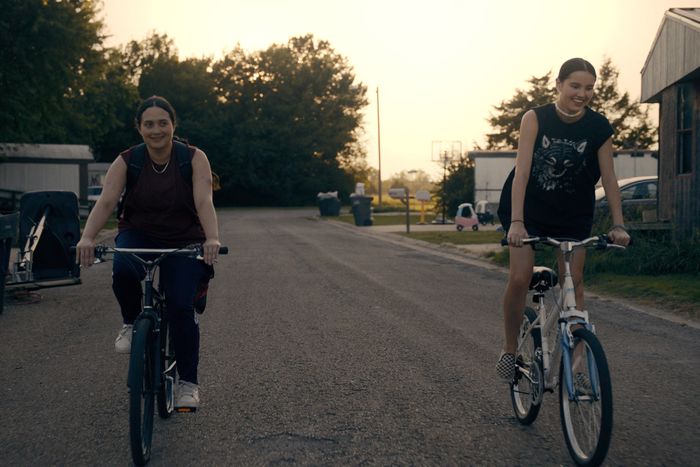
There’s a certain look, a side-eye and smirk, that Lily Gladstone can slide into with as much ease as the sun rising and setting, and that has a similarly illuminating impact. You’ll find this expression throughout her filmography — in Killers of the Flower Moon, Reservation Dogs, Certain Women, Under the Bridge, and now Fancy Dance — and you can measure her character’s wariness and skepticism by how often she deploys it and to whom she directs it. Nearly everyone in Fancy Dance is on the receiving end of this dismissive gaze and rightly so. Here, Gladstone plays Jax, a woman tired of searching for her missing sister and tired of everyone shrugging at her pain. The weight of her fury and sorrow immerses Fancy Dance in an emotional tumult as we witness the negligence and apathy that meets cases of missing and murdered Indigenous women.
Erica Tremblay’s film, which she co-wrote with Miciana Alise, is non-fussy, even sparse, and mostly contained to the Seneca-Cayuga reservation in Oklahoma. It features only about a half-dozen actors, led by the chameleonic Gladstone (in leather-vest-wearing, cigarette-smoking butch glory), the promising Isabel Deroy-Olson as Jax’s niece Roki, and an excellent-per-usual Shea Whigham as Jax’s estranged father, Frank. Jax’s sister Tawi (Hauli Sioux Gray) hasn’t been home in weeks, and Jax is increasingly worried that something terrible has happened to her. The tribal police haven’t done much, claiming to have their hands tied by FBI jurisdiction. The FBI, in turn, is mostly MIA, and when its agents do show up, they brush off questions about how much effort is going into finding missing Indigenous women. No authority figure can be trusted to help Jax. And there’s an unspoken suggestion on the reservation that Tawi, who worked as a stripper and was friendly with her seedier neighbors, might have just run off and abandoned her family. In positioning these obstacles, Fancy Dance communicates how quickly women can be reduced to bodies and statistics.
Fancy Dance takes place over a couple of weeks in the summer, when river crawfish are plentiful enough for Roki to catch under Jax’s supervising eye. The two have an easy familiarity (one of the film’s best visuals is Roki mimicking Jax’s brusque, arms-crossed posture when they try to pawn some stolen goods) and a fierce protectiveness of each other that comes through when Gladstone practically spits at a government official that “there ain’t no father” for Roki, “it’s just three of us here.” But the absence of their third family member, Roki’s mother and Jax’s sister, Tawi, sparks a schism between the two and invites the attention of a number of intruding parties. Child Protective Services, tribal police, the FBI, and Jax and Roki’s white relatives — they all converge on the pair to deem the former drug-dealing and currently stripper-dating Jax a bad influence and the 13-year-old Roki an endangered youth. And that pressure only gets worse when the two take off for a powwow where they hope Tawi might be and don’t tell anyone where they’re going.
From there, Fancy Dance becomes part coming-of-age story, part road movie, and part revenge thriller with Tremblay effectively guiding Gladstone and Deroy-Olson through the tropes of each subgenre. All throughout, it maintains an essential interest in the lives of Native women as Jax and Roki encounter supporting characters of different ages, professions, and economic class. Some of these women stayed on the reservation and some left; some dated outside their tribe and some didn’t; some did work that actively damaged their community, and some retained the traditions that are meant to strengthen it. When Roki dresses up in her mother’s fringed shirt and stripper heels to silently rehearse a powwow routine, she straddles the line between child and adult, heritage and performance, exoticization and self-empowerment — and embodies a multiplicity of experience.
The film’s broad plot beats might recall Taylor Sheridan’s Wind River, in which a Northern Arapaho woman is found dead and two white Americans, one a U.S. Fish and Wildlife Service agent and the other with the FBI, find her killers. But Fancy Dance rejects that film’s racial framing and its treatment of reservations as alien islands within an otherwise homogeneous United States. Instead, it has more in common with Winter’s Bone, which starred Jennifer Lawrence as an Ozarks teen who bumps into local crime lords while searching for her disappeared father. Like that film’s screenplay did, Tremblay and Alise organically incorporate the closely held cultural conventions of their characters (the games they play, the songs they sing, the foods they eat) and emphasize how beliefs are passed down through generations and maintained over time. But every so often Fancy Dance serves up a scene so barbed — like when a power-tripping ICE agent takes notice of Roki and Jax speaking Cayuga and interrogates them on where they’re from — that it’s impossible to miss how this film isn’t just a celebration of Native customs like the powwow. It’s also an indictment of people who can’t stretch their perspectives enough to perceive those rituals in all their detail and splendor, and don’t understand that they’re not for outsiders, anyway. Alongside Gladstone’s expressive performance, Fancy Dance’s ability to choreograph that criticism gives the film a singular grace.
More Movie Reviews
- The Accountant 2 Can Not Be Taken Seriously
- Another Simple Favor Is So Fun, Until It Gets So Dumb
- Errol Morris Has Been Sucked Into the Gaping Maw of True Crime


